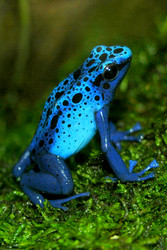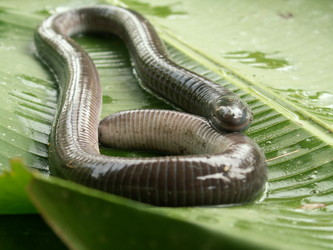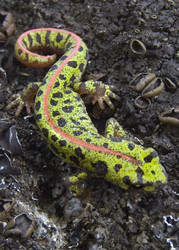Living Amphibians
Frogs and toads, salamanders and newts, and caecilians
David Cannatella


This tree diagram shows the relationships between several groups of organisms.
The root of the current tree connects the organisms featured in this tree to their containing group and the rest of the Tree of Life. The basal branching point in the tree represents the ancestor of the other groups in the tree. This ancestor diversified over time into several descendent subgroups, which are represented as internal nodes and terminal taxa to the right.

You can click on the root to travel down the Tree of Life all the way to the root of all Life, and you can click on the names of descendent subgroups to travel up the Tree of Life all the way to individual species.
For more information on ToL tree formatting, please see Interpreting the Tree or Classification. To learn more about phylogenetic trees, please visit our Phylogenetic Biology pages.
close boxIntroduction
This group, which includes all living amphibians, as well as their extinct relatives, goes by two formal names: Lissamphibia or Amphibia.
References
Bolt, J. R. 1991. Lissamphibian origins. Pages 194–222 in: Origins of the Major Groups of Tetrapods: Controversies and Consensus (H. P. Schultze and L. Trueb, eds.) Cornell University Press, Ithaca, NY.
Duellman, W. E. and L. Trueb. 1994. Biology of Amphibians. Johns Hopkins University Press, Baltimore.
Feller, A. E. and S. B. Hedges. 1998. Molecular evidence for the early history of living amphibians. Mol. Phylogenet. Evol. 9: 509– 516.
Hedges, S. B. and L. R. Maxson. 1993. A molecular perspective on lissamphibian phylogeny. Herpetol. Monogr. 7: 27–42.
Trueb, L. and R. Cloutier. 1991. A phylogenetic investigation of the inter- and intrarelationships of the Lissamphibia (Amphibia: Temnospondyli). Pages 223–313 in: Origins of the Major Groups of Tetrapods: Controversies and Consensus. (H. P. Schultze and L. Trueb, eds.) Cornell University Press, Ithaca, NY.
Trueb, L. and R. Cloutier. 1991. Toward an understanding of the amphibians: two centuries of systematic history. Pages 175–193 in: Origins of the Major Groups of Tetrapods: Controversies and Consensus. (H. P. Schultze and L. Trueb, eds.) Cornell University Press, Ithaca, NY.
Zardoya, R. and A. Meyer. 2000. Mitochondrial evidence on the phylogenetic position of caecilians (Amphibia: Gymnophiona). Genetics 155:765-775.
Zardoya, R., and A. Meyer. 2001. On the origin of and phylogenetic relationships among living amphibians. PNAS 98:7380-7383.
Information on the Internet
- AmphibiaTree. The mission of this project is the realization of a comprehensive phylogeny of all taxa of extant and extinct amphibians.
- Amphibian Species of the World
- AmphibiaWeb.
- Declining Amphibian Population Task Force
- Australian Herpetological Directory
- California Academy of Sciences Herpetology
- Biodiversity and Biological Collections Web Server Herpetology Resources
- Society for the Study of Amphibians and Reptiles
- livingunderworld.org
- Herps of Panama
Title Illustrations

| Location | captive at Atlanta Botanical Gardens |
|---|---|
| Specimen Condition | Live Specimen |
| Source | Blue Poison Dart Frog |
| Source Collection | Flickr |
| Image Use |
 This media file is licensed under the Creative Commons Attribution-NonCommercial-NoDerivs License - Version 2.0. This media file is licensed under the Creative Commons Attribution-NonCommercial-NoDerivs License - Version 2.0.
|
| Copyright | © 2007 Valerie |
| Scientific Name | Gymnopis multiplicata |
|---|---|
| Location | Costa Rica |
| Specimen Condition | Live Specimen |
| Source | Caecilian (Gymnopis multiplicata) |
| Source Collection | Flickr |
| Image Use |
 This media file is licensed under the Creative Commons Attribution-NonCommercial-NoDerivs License - Version 2.0. This media file is licensed under the Creative Commons Attribution-NonCommercial-NoDerivs License - Version 2.0.
|
| Copyright | © 2005 Teague O'Mara |
| Scientific Name | Triturus pygmaeus |
|---|---|
| Location | Madrid, Spain |
| Specimen Condition | Live Specimen |
| Source | Triturus pygmaeus |
| Source Collection | Flickr |
| Image Use |
 This media file is licensed under the Creative Commons Attribution-NonCommercial-NoDerivs License - Version 2.0. This media file is licensed under the Creative Commons Attribution-NonCommercial-NoDerivs License - Version 2.0.
|
| Copyright | © 2008 Alvaro Oporto |
About This Page
David Cannatella

University of Texas, Austin, Texas, USA
Correspondence regarding this page should be directed to David Cannatella at
Page copyright © 2011 David Cannatella
 Page: Tree of Life
Living Amphibians. Frogs and toads, salamanders and newts, and caecilians.
Authored by
David Cannatella.
The TEXT of this page is licensed under the
Creative Commons Attribution License - Version 3.0. Note that images and other media
featured on this page are each governed by their own license, and they may or may not be available
for reuse. Click on an image or a media link to access the media data window, which provides the
relevant licensing information. For the general terms and conditions of ToL material reuse and
redistribution, please see the Tree of Life Copyright
Policies.
Page: Tree of Life
Living Amphibians. Frogs and toads, salamanders and newts, and caecilians.
Authored by
David Cannatella.
The TEXT of this page is licensed under the
Creative Commons Attribution License - Version 3.0. Note that images and other media
featured on this page are each governed by their own license, and they may or may not be available
for reuse. Click on an image or a media link to access the media data window, which provides the
relevant licensing information. For the general terms and conditions of ToL material reuse and
redistribution, please see the Tree of Life Copyright
Policies.
- Content changed 28 November 2008
Citing this page:
Cannatella, David. 2008. Living Amphibians. Frogs and toads, salamanders and newts, and caecilians. Version 28 November 2008 (under construction). http://tolweb.org/Living_Amphibians/14997/2008.11.28 in The Tree of Life Web Project, http://tolweb.org/











 Go to quick links
Go to quick search
Go to navigation for this section of the ToL site
Go to detailed links for the ToL site
Go to quick links
Go to quick search
Go to navigation for this section of the ToL site
Go to detailed links for the ToL site